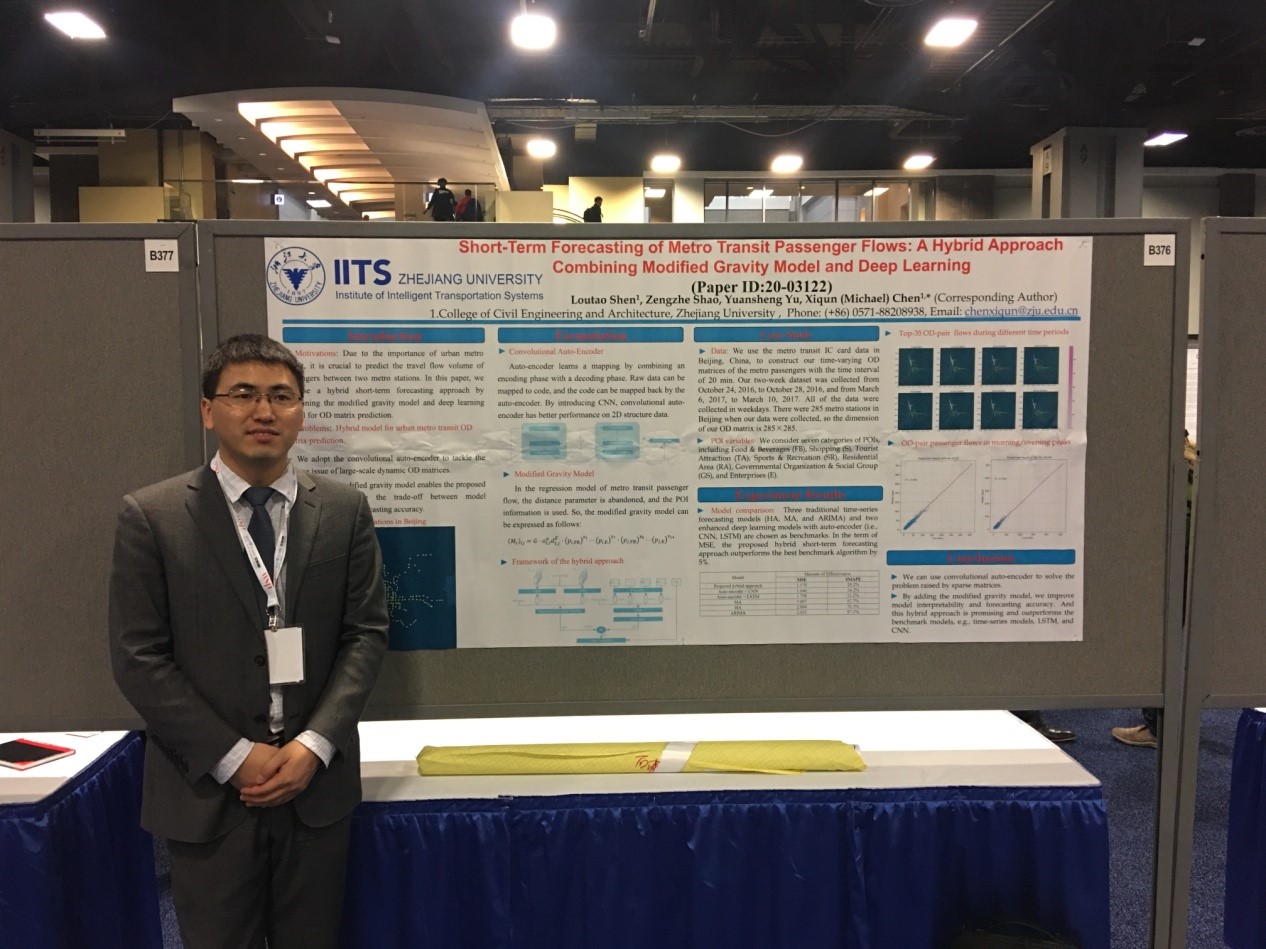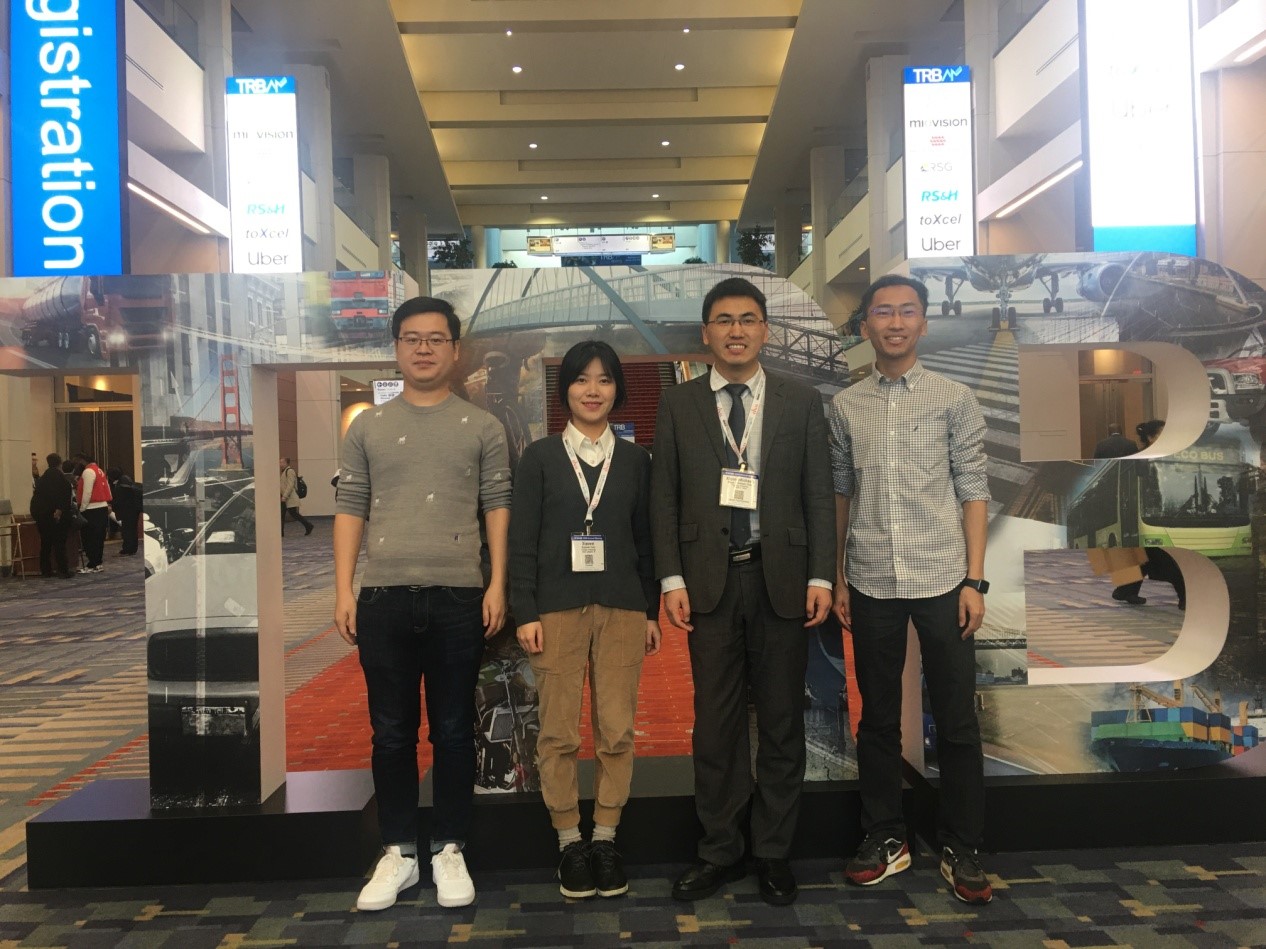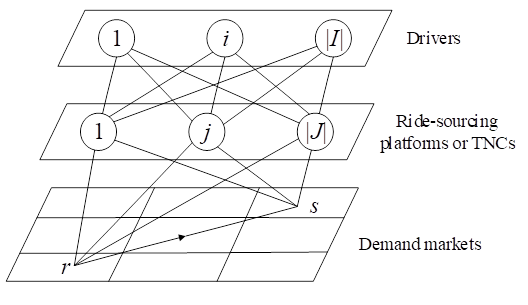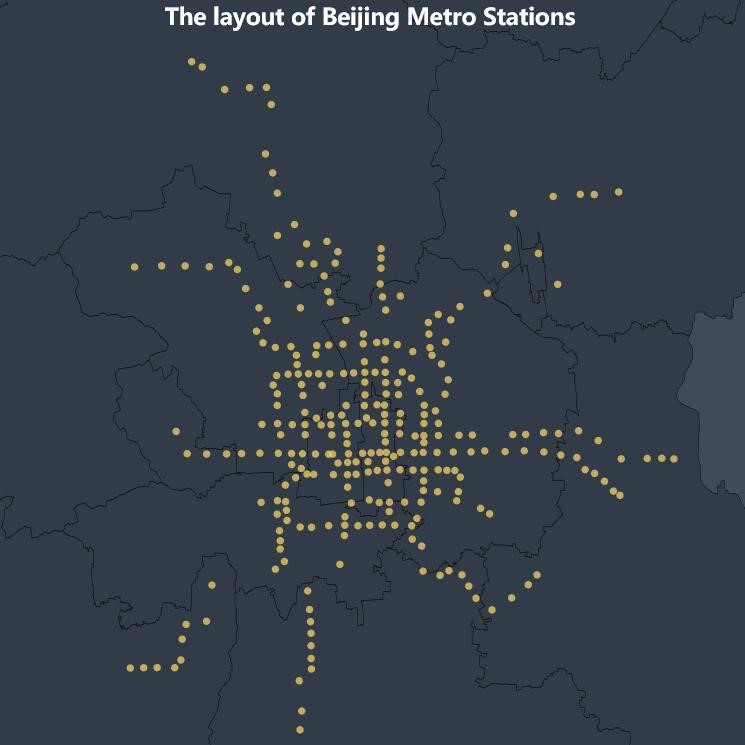发布时间:2020-05-04 16:42:05
2020年1月11-18日,陈喜群博士赴美国华盛顿特区参加第99届美国交通运输研究委员会年会(The 99th Transportation Research Board Annual Meeting),并展示两篇论文的学术墙报(图1)。


图1 陈喜群博士及课题组研究生参加TRB年会
宣讲论文“Network equilibrium analysis of competitive ride-sourcing market”在管理者(网约车企业)、运营方(个体司机)、出行者(需求市场)的非合作博弈理论的基础上,为网约车市场建立起止点时空分布竞争网络均衡模型,假设每个网约车企业(RSE)和个体司机都追求利润最大化,而需求市场追求效用最大化,通过均衡理论取得最优解(图2)。研究结果包括:(1)市场均衡价格随着交易成本、司机成本或平台成本的上升而提高,市场均衡出行总量随着交易成本、司机成本或平台成本的上升而减少;(2)轻资产网约车平台数量的增加,会降低市场均衡价格,增加市场均衡出行总量;(3)增加RSM进入要求会提高市场均衡价格,减少RSM出行总量。该研究结果有助于辅助政府制定监管正常和网约车企业决策。

图2 网约车出行市场竞争网络示意图
宣讲论文“Short-term forecasting of metro transit passenger flows: A hybrid approach combining modified gravity model and deep learning”将修正的重力模型与深度学习模型(如卷积神经网络与自编码器)相结合,提出了一种混合的短期预测方法。这种混合预测方法由三部分组成:(1)将地铁站周围地理信息和车站流入/流出量作为回归属性的修正重力模型:(2)解决客流OD矩阵稀疏性问题的卷积式自动编码器:(3)物理回归结果与解码器矩阵的融合,利用反向传播算法调整最优融合权参数矩阵。该模型能够在可解释性和预测准确性之间取得平衡。将该方法应用于北京地铁客流的短期预测,实验结果表明,该混合方法具有良好的预测精度,其性能优于时间序列模型、LSTM模型和CNN等基准模型。应用结果表明,所提出的混合短期预测方法不仅适用于车站层次的客流预测,而且适用于车站间OD客流预测。地铁短期客流预测对城市地铁系统在列车调度、乘务调度、缓解拥堵策略、运营决策和动态信息提供等方面具有重要意义。

图3 北京地铁站点分布图
本研究得到了国家自然科学基金与欧洲城市化联合研究计划(JPI UE)中欧合作研究项目“城市公共管理与服务革新:新型的城市移动管理与政策”(项目号71961137005)及其他相关项目的资助。
UPASS Project Member Attended the 99th TRB Annual Meeting, January 11-18, 2020, Washington DC
The UPASS Project Member, Dr. Xiqun (Michael) Chen, attended the 99th Transportation Research Board Annual Meeting and presented two papers in poster sessions (Fig. 1 and Fig. 2). The 99th TRB Annual Meeting was held in Washington, DC, during January 11-18, 2020. The theme for the 2020 TRB Annual Meeting is “A Century of Progress Foundation for the Future”. There were more than 5,000 presentations in nearly 800 sessions and workshops, addressing topics of interest to policy makers, administrators, practitioners, researchers, and representatives of government, industry, and academic institutions.

Fig. 1. Dr. Xiqun (Michael) Chen attended the 99th TRB Annual Meeting

Fig. 2. Dr. Xiqun (Michael) Chen’s research team at the 99th TRB Annual Meeting
(a) Network equilibrium analysis of competitive ride-sourcing market
This study proposes an origin-destination (OD) competitive network equilibrium model for RSM based on the non-cooperative game theory. Specifically, the finite-dimensional variational inequality theory is adopted to establish the OD-based ride-sourcing enterprise (RSE) competition equilibrium model (Fig. 3). The model assumes that RSE and individual drivers seek to maximize profits, while demand markets seek utility maximization. The analytical findings include that: (1) the market equilibrium price increases and the market equilibrium travel quantity decreases in either the transaction cost, driver cost, or RSE cost; (2) the increased number of light-asset RSEs will decrease the market equilibrium price and increase the market equilibrium travel quantity, and (3) increasing RSM entry requirements improves the market equilibrium price and reduces the travel demand on the RSM. The gained analytical insights shed light on RSEs and the government to improve their strategic and operational decisions.

Fig. 3. Competitive network of on-demand ride services
(b) Short-term forecasting of metro transit passenger flows: A hybrid approach combining modified gravity model and deep learning
Due to the importance of urban metro transit, it is crucial to predict the travel flow volume of passengers between two metro stations. In this study, hybrid short-term forecasting approach is proposed by combining the modified gravity model and deep learning model for OD matrix prediction. To demonstrate the hybrid approach developed in this paper, the metro transit IC card data in Beijing, China, are utilized to construct our time-varying OD matrices of the metro passengers with the time interval of 20 min (Fig. 4). In conclusion, Dr Chen’s research team uses convolutional auto-encoder to solve the problem raised by sparse matrices. In addition, by adding the modified gravity model, model interpretability and forecasting accuracy are improved. This hybrid approach is promising and outperforms the benchmark models, e.g., time-series models, LSTM, and CNN.

Fig. 4. The layout of metro stations in Beijing
The above research was supported by the joint project of the JPI Urban Europe and National Natural Science Foundation of China "Urban Public Administration and ServiceS innovation for Innovative Urban Mobility Management and Policy (U-PASS)" (Grant No. 71961137005) and other related projects.